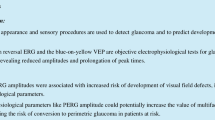Abstract
Thirty-two eyes with idiopathic macular holes and one eye with a traumatic macular hole were assessed by pattern-reversal electroretinography, ganzfeld electroretinography and pattern-reversal visual evoked potentials. Results were inspected for qualitative abnormalities and then measured in comparison with fellow eyes and 41 control eyes of similar age. Qualitative abnormalities occurred in some eyes with macular holes, most commonly a reduction in pattern-reversal electroretinogram or pattern-reversal visual evoked potential amplitude; 15′ check amplitudes were significantly lower in eyes with macular holes than in control eyes, but no significant difference in latency was found. Control pattern-reversal electroretinogram and pattern-reversal visual evoked potential amplitudes were noted to decline with age, and paired t-tests on an age-matched subgroup of eyes with macular holes and control eyes showed appreciable differences only in the pattern-reversal electroretinogram q-r (N95) amplitude.
Similar content being viewed by others
References
Biersdorf WR, Diller DA. Local electroretinogram in macular degeneration. Am J Ophthalmol 1969; 68: 296–303.
Vaegan, Billson FA. Macular electroretinograms and contrast sensitivity as sensitive detectors of early maculopathy. Doc Ophthalmol 1986; 63: 399–406.
Fish GE, Birch DG. The focal electroretinogram in the clinical assessment of macular disease. Ophthalmology 1989; 96: 109–14.
Vaegan, Billson FA. Macular electroretinograms. Their accuracy, specificity and implementation for clinical use. Aust J Ophthalmol 1984; 12: 359–72.
Bankes JL. The foveal electroretinogram. Trans Ophthalmol Soc UK 1967; 87: 249–69.
Miyake Y, Shiroyama N, Ota I, Horiguchi M. Local macular electroretinographic responses in idiopathic central serous chorioretinopathy. Am J Ophthalmol 1988; 106: 546–50.
Sherman J. Simultaneous pattern reversal electroretinograms and visual evoked potentials in diseases of the macula and optic nerve. Ann NY Acad Sci 1982; 388: 214–26.
Arden GB, Carter RM, MacFarlan A. Pattern and ganzfeld electroretinograms in macular disease. Br J Ophthalmol 1984; 68: 878–84.
Holder GE. Significance of abnormal pattern electroretinography in anterior visual pathway dysfunction. Br J Ophthalmol 1987; 71: 166–71.
Kaufman D, Celesia GG. Simultaneous recording of pattern electroretinogram and visual evoked responses in neuroophthalmologic disorders. Neurology 1985; 35: 644–51.
Kirkham TH, Coupland SG. Abnormal pattern electroretinograms with macular cherryred spots: Evidence for selective ganglion cell damage. Curr Eye Res 1981; 1: 367–72.
Kornzweig AL, Feldstein M. Studies of the macula in old age. Am J Ophthalmol 1950, 33: 243–53.
Frangieh GT, Green WR, Engel HM. A histopathologic study of macular cysts and holes. Retina 1981; 1: 311–36.
Gass JDM. Idiopathic macular hole: Its early stages and pathogenesis. Arch Ophthalmol 1988; 106: 629–39.
Gass JDM. A stereoscopic atlas of macular diseases: Diagnosis and treatment. 3rd ed. St. Louis: CV Mosby; 1987; 671–93.
Trempe CL, Weiter JJ, Furukawa H. Fellow eyes in cases of macular hole: Biomicroscopic study of the vitreous. Arch Ophthalmol 1986; 104: 93–95.
Morgan CM, Schatz H. Idiopathic macular holes. Am J Ophthalmol 1985; 99: 437–44.
McDonnell PJ, Fine SL, Hillis AI. Clinical features of idiopathic macular cysts and holes. Am J Ophthalmol 1982; 93: 777–86.
Aaberg TM, Blair CJ, Gass JDM. Macular holes. Am J Ophthalmol 1970; 69: 555–62.
Avila MP, Jalkh AE, Murukami K, Trempe CL, Schepens CL. Biomicroscopic study of the vitreous in macular breaks. Ophthalmology 1983; 90: 1277–83.
Rees AB, Jones IS, Cooper WC. Macular changes secondary to vitreous traction. Am J Ophthalmol 1967; 64: 544–69.
Margherio RR, Schepens CL. Macular breaks: Diagnosis, etiology and observations. Am J Ophthalmol 1972; 74: 219–32.
Smiddy WE, Michels RG, Glaser BM, de Bustros S. Vitrectomy for impending macular holes. Am J Ophthalmol 1988; 105: 371–76.
Brown GC. Macular hole following rhegmatogenous retinal detachment repair. Arch Ophthalmol 1988; 106: 765–66.
Bass SJ, Sherman J, Bodis-Wollner I, Nath S. Visual evoked potentials in macular disease. Invest Ophthalmol Vis Sci 1985; 26: 1071–74.
Johnson LN, Yee RD, Hepler RS, Martin DA. Alteration of the visual evoked potential by macular holes: Comparison with optic neuritis. Graefes Arch Clin Exp Ophthalmol 1987; 225: 123–8.
Straatsma BR, Foos RY, Spencer LM. The retina. Topography and clinical correlations. (Symposium on retina and retinal surgery.) Trans New Orleans Acad Ophthalmol St. Louis: CV Mosby; 1969; 1–26.
Birch DG, Jost BF, Fish FE. The focal electroretinogram in fellow eyes of patients with idiopathic macular holes. Arch Ophthalmol 1988; 106: 1558–63.
Trick GL, Trick LR, Haywood KM. Altered human pattern evoked retinal and cortical potentials associated with human senescence. Curr Eye Res 1986; 5: 717–24.
Mitchell KW, Howe JW, Spencer SR. Visual evoked potentials in the older population: Age and gender effects. Clin Phys. Physiol Meas 1987; 8: 317–24.
Bobak P, Bodis-Wollner I, Guillory S, Anderson R. Aging differentially delays visual evoked potentials to checks and gratings. Clin Vis Sci 1989; 4: 269–74.
Maffei L, Fiorentini A, Bisti S, Hollander H. Pattern ERG in the monkey after section of the optic nerve. Exp Brain Res 1985; 59: 423–25.
Hollander H, Bisti S, Maffei L, Hebel R. Electroretinographic responses and retrograde changes of retinal morphology after intracranial optic nerve section: A quantitative analysis in the cat. Exp Brain Res 1984; 55: 483–93.
Vaegan, Arden GB, Hogg CR. Properties of normal electroretinograms evoked by patterned stimuli in man: Abnormalities in optic nerve disease and amblyopia. Doc Ophthalmol Proc Ser 1982; 31: 111–29.
Arden GB, Vaegan, Hogg CR. Clinical and experimental evidence that the pattern electroretinogram is generated in more proximal retinal layers than the focal electroretinogram. Ann NY Acad Sci 1982; 388: 580–601.
Dodt E. The electrical response of the human eye to patterned stimuli: Clinical observations. Doc Ophthalmol 1987; 65: 271–86.
Author information
Authors and Affiliations
Rights and permissions
About this article
Cite this article
Smith, R.G., Brimlow, G.M., Hardman Lea, S.J. et al. Evoked responses in patients with macular holes. Doc Ophthalmol 75, 135–144 (1990). https://doi.org/10.1007/BF00146549
Accepted:
Issue Date:
DOI: https://doi.org/10.1007/BF00146549




